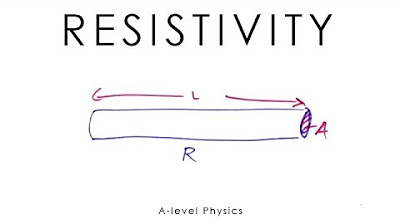A Level Physics: What is resistivity?
TLDRIn this educational video, the concept of resistivity is explored through a discussion on how the length and cross-sectional area of a wire affect its resistance. The video explains that resistance is directly proportional to the length of the wire and inversely proportional to its cross-sectional area. The resistivity (denoted by the Greek letter rho) is introduced as the constant of proportionality and is given in units of ohm-meters. A practical problem is solved by calculating the resistance of a copper wire with a specific length and diameter, using the provided resistivity value for copper. The video serves as an informative guide for those interested in understanding the fundamentals of electrical resistance and resistivity.
Takeaways
- 🌟 The longer a wire is, the greater its resistance will be due to more collisions between electrons and ions.
- 📏电阻(Resistance)与导线长度(Length)成正比。
- 🔍 A wire with a smaller cross-sectional area (a) will have a higher resistance compared to one with a larger cross-sectional area.
- 🔄电阻与横截面积(Cross-sectional area)成反比。
- 📌 电阻率(Resistivity)是描述材料对电流阻碍程度的物理量,用希腊字母ρ(rho)表示。
- 🔧 电阻率的单位是欧姆·米(ohm meters)。
- 🧠 电阻(R)的计算公式是电阻率(ρ)乘以长度(L)除以横截面积(A)。
- 🛠️ 铜的电阻率大约是1.7 x 10^-8 ohm meters。
- 📐 对于一个直径为0.15毫米的2米长的铜线,其电阻大约是1.9欧姆。
- 📝 在计算电阻时,需要注意单位转换,如毫米到米的转换。
- 🎓 理解电阻率的概念对于解决电路问题和材料选择至关重要。
- 📱 如果有疑问,可以通过评论区进行交流和讨论。
Q & A
What is resistivity and how is it related to resistance?
-Resistivity is a property of a material that quantifies how strongly it resists the flow of electric current. It is directly related to resistance, as resistance is calculated by the formula R = ρ * L / A, where R is resistance, ρ is resistivity, L is the length of the conductor, and A is the cross-sectional area.
How does the length of a wire affect its resistance?
-The resistance of a wire is directly proportional to its length. The longer the wire, the greater the resistance, due to more collisions between conducting electrons and positive ions within the conductor over a greater length.
What is the relationship between the cross-sectional area of a wire and its resistance?
-The resistance of a wire is inversely proportional to its cross-sectional area. A wire with a smaller cross-sectional area will have a higher resistance because there are fewer conducting electrons available, while a larger cross-sectional area will have a lower resistance due to more conducting electrons.
What is the unit of measurement for resistivity?
-Resistivity is measured in ohm meters (Ω·m), which is derived from the units of resistance (ohms), area (square meters), and length (meters) used in its defining equation.
How do you calculate the resistance of a wire?
-The resistance of a wire can be calculated using the formula R = ρ * L / A, where R is the resistance, ρ is the resistivity of the material, L is the length of the wire, and A is the cross-sectional area of the wire.
What is the resistivity of copper given in the script?
-The resistivity of copper is given as 1.7 × 10^-8 ohm meters.
How do you find the cross-sectional area of a wire with a given diameter?
-The cross-sectional area of a wire can be found using the formula A = π * (d/2)^2, where d is the diameter of the wire. For a wire with a diameter of 0.15 millimeters, the area would be calculated by first converting millimeters to meters (using a factor of 10^-3) and then applying the formula.
What is the significance of resistivity in electrical engineering?
-Resistivity is a crucial parameter in electrical engineering as it helps in determining the efficiency of electrical systems. Materials with low resistivity are preferred for conducting wires to minimize energy loss due to resistance.
How does temperature affect resistivity?
-For most conductors, resistivity increases with temperature. As temperature rises, the atoms in the material vibrate more, causing more collisions with the conduction electrons and thus increasing the resistance.
What are some factors that can change the resistivity of a material?
-Resistivity can be affected by various factors including temperature, material composition, impurities, and the presence of defects or lattice imperfections within the material.
How does the shape of a conductor influence its resistance?
-The shape of a conductor affects its resistance through its length and cross-sectional area. Longer and narrower conductors have higher resistance, while shorter and wider conductors have lower resistance.
What is the role of resistivity in the design of electrical devices?
-In the design of electrical devices, the resistivity of materials is a critical factor. Engineers must select materials with appropriate resistivity to ensure that the devices operate efficiently and safely, with minimal energy loss due to resistance.
Outlines
🌟 Introduction to Resistivity and its Impact on Wire Resistance
This paragraph introduces the concept of resistivity and its effect on the resistance of wires. It begins by posing a question about the resistance of two wires of different lengths, leading to the conclusion that the longer wire has greater resistance due to more collisions between electrons and ions. The explanation then moves on to discuss the impact of cross-sectional area on resistance, stating that a smaller cross-sectional area results in higher resistance because there are fewer conducting electrons available. The paragraph concludes by defining resistivity (denoted by the Greek letter rho) as the constant of proportionality between resistance and the product of length and cross-sectional area, with units of ohm-meters.
🧠 Applying Resistivity to Calculate Wire Resistance
This paragraph delves into the practical application of resistivity by using it to calculate the resistance of a copper wire. It provides the formula for resistance, incorporating resistivity, length, and cross-sectional area. Using the given resistivity value for copper and the specific dimensions of the wire (2 meters in length and 0.15 millimeters in diameter), the paragraph guides through the calculation process. It explains the need to convert the diameter to radius and account for unit conversion (millimeters to meters) by using a factor of 10 to the power of -3. The final step involves calculating the cross-sectional area using the formula for the area of a circle (pi times radius squared) and then determining the resistance, which is found to be approximately 1.9 ohms. The paragraph concludes by encouraging viewers to attempt the problem and engage with the content by leaving comments if they have questions.
Mindmap
Keywords
💡Resistivity
💡Resistance
💡Conductor
💡Cross-Sectional Area
💡Length
💡Current
💡Colliding Electrons
💡Ohm's Law
💡Copper Wire
💡Diameter
💡Electrical Conduction
Highlights
The introduction of resistivity as a physical concept.
Comparison of resistance between two wires of different lengths.
Explanation that longer wires have greater resistance due to more collisions.
Discussion on the relationship between resistance and the cross-sectional area of a wire.
Assertion that smaller cross-sectional area results in higher resistance.
Introduction of resistivity as the constant of proportionality between resistance and the product of length and cross-sectional area.
Equation rearrangement to solve for resistivity.
Units of resistivity are ohm-meters.
Application of resistivity concept to calculate the resistance of a copper wire.
Use of resistivity value for copper to perform a practical calculation.
Explanation of how to derive the cross-sectional area of a wire.
Conversion of units from millimeters to meters for calculation purposes.
Final calculation result of 1.9 ohms for the resistance of the wire.
Encouragement for viewers to pause and attempt the problem independently.
Summary and invitation for viewers to ask questions for further clarification.
Transcripts
Browse More Related Video

Resistance of a Conductor | Electricity and Circuits | Don't Memorise

Resistivity - A Level Physics

Resistivity - A-level Physics

Resistivity and conductivity | Circuits | Physics | Khan Academy

High School Physics - Resistance, Resistors, and Resistivity

Resistivity and Resistance Formula, Conductivity, Temperature Coefficient, Physics Problems
5.0 / 5 (0 votes)
Thanks for rating: